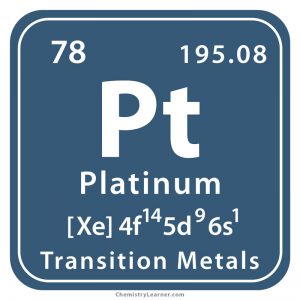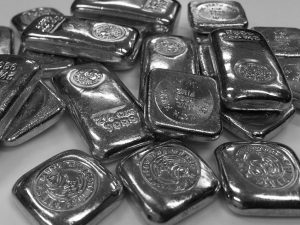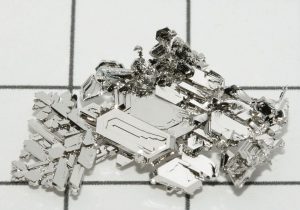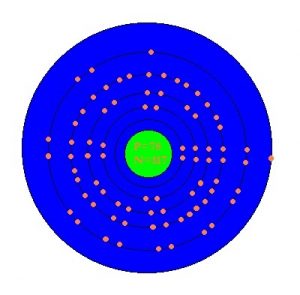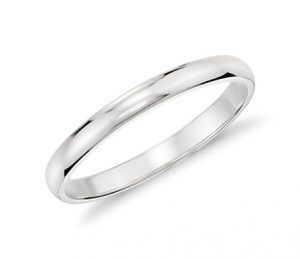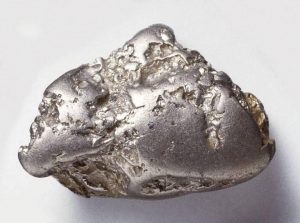Platinum
What is Platinum
Platinum (pronunciation PLAT-en-em [2]), represented by the chemical symbol or formula Pt [1], is a soft, heavy, malleable, ductile and extremely rare element belonging to the family of transition metals [3, 11]. Naturally occurring Pt is a mixture of 6 isotopes with mass numbers 190, 192, 194-196 and 198 [1, 3]. Besides that, it has 35 synthetic isotopes with known half-lives [3]. It is chemically inert and at any temperature, doesn’t oxidize in air. Though it’s resistant to acids it dissolves readily in aqua regia. It reacts with bases and halogens [4].
Where Is It Found
Platinum is found in the uncombined state in alluvial deposits. Commercial platinum is mainly sourced from the mineral cooperite (platinum sulfide) in South Africa. Some platinum is also obtained as a by-product of nickel and copper refining [1].
History
Origin of Its Name: Its name is derived from the Spanish “platina” meaning little silver [1].
Who Discovered Platinum: Unknown [1].
When Was It Discovered: It was known to native South Americans before Columbus and was taken to Europe around 1750 [1].
How Was It Discovered
In 1557, Julius Scaliger, an Italian scholar, wrote of a metal from Spanish central America that could not be melted. In 1735, Spanish scientist Antonio Ulloa found this curious metal and was returning to Europe with it but his ship was captured and brought to London by the Royal Navy. The members of the Royal Society were interested in the new metal and that is how platinum came to be reported and discussed throughout Europe [1].
Platinum Identification |
|||
| Atomic Number | 78 [1] | ||
| CAS Number | 7440-06-4 [1] | ||
| Position in the periodic table | Group | Period | Block |
| 10 [1] | 6 [1] | d [1] | |
Properties and Characteristics of Platinum
General Properties |
||
| Atomic mass | 195.084 atomic mass units [1] | |
| Atomic weight | 195.084 [1] | |
| Molar mass/molecular weight | 195.084 g/mol [5] | |
Physical Properties |
||
| Color/appearance | Silvery-white [3] | |
| Melting point/freezing point | 1768.2°C, 3214.8°F [1] | |
| Boiling point | 3825°C, 6917°F [1] | |
| Density | 21.5 g cm-3 [1] | |
| State of matter at room temperature (normal phase) | Solid [1] | |
| Electrical Conductivity | 9.4X106 S/m [6] | |
| Specific heat | 0.13 kJ/kg K [7] | |
| Resistivity | 10.6X10-8 ohm-m [8] | |
| Temperature coefficient | 0.003927 [8] | |
| Conductivity | 0.943X107/ohm-m [8] | |
| Hardness (Mohs scale) | 3.5 [9] | |
| Tensile strength | 120 MPa [10] | |
Chemical Properties |
||
| Oxidation state/Oxidation number | (−3), (−2), (−1), (+1), +2, (+3), +4, +5, +6 [1] | |
Magnetic Properties |
||
| Magnetic ordering | Paramagnetic [12] | |
Atomic Data of Platinum (Element 78)
| Valence electrons | 6 [13] | |||||||
| Quantum numbers | ||||||||
| – n | 5 [14] | |||||||
| – ℓ | 2 [14] | |||||||
| – m ℓ | 0 [14] | |||||||
| – m s | -½ [14] | |||||||
| Electron configuration (noble gas configuration) | [Xe] 4f145d96s1 [1] | |||||||
| Crystal structure | Cubic close-packed [15] | |||||||
| Atomic structure | ||||||||
| – Number of Electrons | 78 [3] | |||||||
| – Number of Neutrons | 117 [3] | |||||||
| – Number of Protons | 78 [3] | |||||||
| Energy levels [3] | ||||||||
| – First Energy Level | 2 | |||||||
| – Second Energy Level | 8 | |||||||
| – Third Energy Level | 18 | |||||||
| – Fourth Energy Level | 32 | |||||||
| – Fifth Energy Level | 17 | |||||||
| – Sixth Energy Level | 1 | |||||||
| Radius of atom | ||||||||
| – Atomic Radius | 2.13 Å [1] | |||||||
| – Covalent Radius | 1.30 Å [1] | |||||||
| Electronegativity (Pauling scale) | 2.2 [1] | |||||||
| Ionization energy
(kJmol-1) [1] |
1st | 2nd | 3rd | 4th | 5th | 6th | 7th | 8th |
| 864.393 | 1791.057 | – | – | – | – | – | – | |
Platinum Uses
- Its main use is in the catalytic converters of cars, buses and trucks. It can effectively convert the vehicle engine emissions into less harmful waste products [1].
- It is extensively used in jewelry [1].
- In the chemical industry, it is used as catalyst in the production of silicone, benzene and nitric acid. Its catalytic properties also help in improving the efficiency of fuel cells [1].
- It has applications in the electronic industry in the manufacture of thermocouples and computer hard disks [1].
- To make turbine blades, optical fibers, pacemakers, spark plugs, dental fillings, LCDs, etc [1].
- Platinum compounds used as chemotherapy drugs play an important role in treating cancer [1].
Is It Dangerous
The metal is non-toxic [1].
Interesting Facts
- It is a very corrosion resistant metal like gold, though it is much costlier [1, 2].
Platinum (Pt Element) Cost
The pure metal is priced at $13,000 for every 100 gram and in bulk, the same quantity costs $5,000 [3].
- References
- http://www.rsc.org/periodic-table/element/78/platinum
- https://education.jlab.org/itselemental/ele078.html
- https://www.chemicool.com/elements/platinum.html
- https://nature.berkeley.edu/classes/eps2/wisc/pt.html
- https://pubchem.ncbi.nlm.nih.gov/compound/platinum
- http://periodictable.com/Properties/A/ElectricalConductivity.an.html
- https://www.engineeringtoolbox.com/specific-heat-metals-d_152.html
- http://hyperphysics.phy-astr.gsu.edu/hbase/Tables/rstiv.html
- https://www.alansfactoryoutlet.com/the-hardness-of-metals-a-visual-representation-of-mohs-scale
- https://www.quora.com/Is-platinum-the-strongest-metal
- https://www.explainthatstuff.com/platinum.html
- https://pubs.acs.org/doi/abs/10.1021/acscatal.9b04689
- http://periodictable.com/Properties/A/Valence.al.html
- http://chemistry-reference.com/q_elements.asp?Symbol=Pt&language=en
- https://www.webelements.com/platinum/crystal_structure.html
